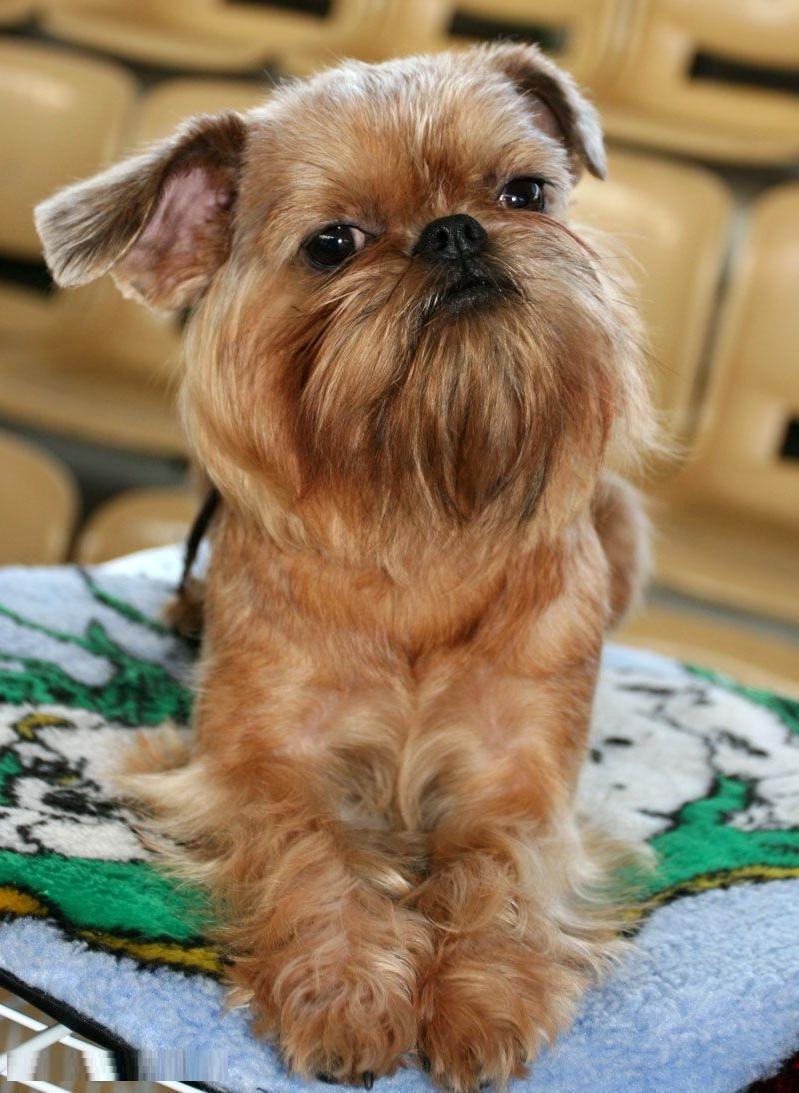- Breed Category: Toy
- Country of Origin: Belgium
- Average Height: 18-20 cm (7-8 inches)
- Average Weight: 3.2-5.5 kg (7-12 lbs)
- Average Life Span: 12-15 years
- Grooming Requirements: Moderate, regular brushing needed
- Exercise Requirements: Low, short daily walks
- Coat Type: Rough or smooth
- Coat Color Variations: Red, black, black & tan
- Shedding Level: Low
- Ear Type: Small, set high
- Tail Type: High-set, often docked
- Temperament: Affectionate, alert, curious
- Intelligence Level: High
- Barking Tendency: Moderate
- Compatibility with Children: Good with older children
- Compatibility with Other Pets: Generally good
- Training Ease: Moderate, needs patience
- Common Health Issues: Hip dysplasia, eye problems
- Dietary Needs: High-quality small breed diet
- Energy Level: Moderate
- Drooling Tendency: Low
- Sensitivity to Weather: Sensitive to extreme temperatures
- Overall Maintenance Level: Moderate
- Original Purpose: Ratting, companion
- Year of Recognition by Kennel Clubs: 1880s
- Apartment Friendly: Yes
- Best Suited For: Families, singles, seniors
- Cost of Ownership: Moderate
- Unique Traits: Human-like expressions
- Popularity Rank: Moderate
Did you know that the Brussels Griffon, with its distinctive whiskered face, is one of the most expressive dog breeds? This little dog, often weighing less than 5 kilograms, packs a lot of personality into a small frame. In this article, we’ll explore the unique characteristics, rich history, and essential care tips for the Brussels Griffon.
Originating from Belgium, this breed was initially bred to hunt vermin in stables. Over time, their charming looks and lively nature made them popular companions among European nobility. Today, they’re cherished for their intelligence and affectionate nature. Understanding their past helps us appreciate their present, and knowing how to care for them ensures a happy, healthy life for these delightful dogs.
The Fascinating History and Characteristics of the Brussels Griffon

Early Development of the Breed
The Brussels Griffon has its roots in Belgium, where it was originally bred to keep stables free of rats. These small dogs were adept at hunting vermin, thanks to their agility and keen senses. Over time, their unique appearance and spirited personality caught the attention of the upper class, leading to their rise in popularity as companion animals.
Role in European History and Popularity
As the breed gained favour among European nobility, the Brussels Griffon became a symbol of status and elegance. Their expressive faces and lively demeanour made them a favourite in royal courts, further cementing their place in history. This popularity spread across Europe, and eventually, the breed found admirers worldwide.
Key Historical Figures and Events
Queen Marie Henriette of Belgium was instrumental in the breed’s development, as she was an avid enthusiast. Her interest helped elevate the Brussels Griffon’s status, leading to more refined breeding practices. This royal endorsement played a significant role in shaping the breed we know today.
Physical Characteristics
Brussels Griffons are small, typically weighing under 5 kilograms, but they have a robust build. Their most striking feature is their expressive, almost human-like face, complete with a whiskered muzzle. They come in a variety of colours, including red, black, and tan, and their coat can be either smooth or rough, adding to their unique charm.
Appearance and Unique Traits
Brussels Griffons are small but sturdy, with a weight that rarely exceeds 5 kilograms. Their compact size is complemented by a robust build, making them surprisingly resilient. One of their most captivating features is their expressive face, often compared to that of a human. This is accentuated by their large, soulful eyes and a distinctive beard that gives them a wise, almost comical appearance. Their coat can be either smooth or rough, with colours ranging from red to black and tan, each adding to their unique allure.
Temperament and Behaviour
These little dogs are known for their lively and affectionate nature. They thrive on human companionship and are often described as being very people-oriented. Despite their small size, they have a big personality, often displaying a curious and inquisitive nature. Brussels Griffons are intelligent and can be quite independent, yet they form strong bonds with their families, making them loyal companions. Their spirited temperament makes them both entertaining and endearing, ensuring they are always the centre of attention.
Personality and Suitability as a Family Pet

Typical Personality Traits
Brussels Griffons are affectionate, alert, and curious. They love being around people and are known for their lively and engaging personalities. These little dogs are always eager to explore their surroundings, making them both entertaining and delightful companions.
Suitability as a Family Pet
With their loving nature, Brussels Griffons make excellent family pets. They thrive in environments where they receive plenty of attention and affection. Their small size and gentle disposition make them well-suited for families, even those with limited space.
Interaction with Children and Other Animals
Brussels Griffons generally get along well with children, especially if they are raised together. They enjoy playtime and can be quite patient with kids. However, it’s important to supervise interactions to ensure gentle handling. They can also coexist peacefully with other pets, particularly if socialised from a young age.
Training and Exercise Needs
These dogs are intelligent and respond well to positive reinforcement training. Consistent, gentle training methods work best. While they don’t require extensive exercise, regular walks and play sessions are essential to keep them happy and healthy. Their curious nature means they enjoy activities that challenge their minds as well.
Training, Exercise, and Health of the Brussels Griffon
Importance of Early Training and Socialisation
Starting training and socialisation early is crucial for Brussels Griffons. These little dogs are intelligent and curious, so introducing them to various environments, people, and other animals helps them grow into well-rounded companions. Early exposure reduces the risk of behavioural issues and ensures they adapt well to different situations.
Recommended Training Techniques
Brussels Griffons respond best to positive reinforcement techniques. Reward-based training, using treats and praise, encourages them to learn quickly and happily. Consistency is key, as these dogs can be a bit stubborn. Short, engaging training sessions work wonders, keeping their attention and making learning fun.
Daily Exercise Requirements and Activities They Enjoy
While they don’t need extensive exercise, Brussels Griffons benefit from daily walks and playtime. They enjoy activities that challenge their minds, like puzzle toys or interactive games. Regular exercise keeps them fit and prevents boredom, which can lead to unwanted behaviours.
Health and Lifespan
Brussels Griffons are generally healthy, with a lifespan of 12 to 15 years. Regular vet check-ups, a balanced diet, and proper dental care are essential to maintain their health. Being aware of breed-specific issues, like respiratory problems, helps in providing the best care for these delightful dogs.
Health and Care of the Brussels Griffon
Common Health Issues
Brussels Griffons are generally healthy, but like any breed, they can be prone to certain health issues. Common concerns include respiratory problems due to their short noses, eye conditions, and hip dysplasia. Regular vet visits are crucial to catch any potential issues early.
Average Lifespan and Health Tips
These charming dogs typically live between 12 to 15 years. To keep them healthy, ensure they have a balanced diet, regular exercise, and mental stimulation. Keeping their weight in check is important to avoid stress on their joints.
Preventative Care Recommendations
Preventative care is key. Regular vaccinations, flea and tick prevention, and dental care are essential. Routine check-ups with the vet will help monitor their overall health and catch any issues before they become serious.
Grooming and Maintenance
Brussels Griffons require regular grooming, especially if they have a rough coat. Weekly brushing helps prevent matting and keeps their coat healthy. Regular ear cleaning and nail trimming are also important parts of their grooming routine.
Coat Care and Grooming for the Brussels Griffon

Coat Care and Grooming Routines
Brussels Griffons have two coat types: smooth and rough. Each requires a different grooming approach. Smooth-coated Griffons need regular brushing to remove loose hair and maintain a shiny coat. A soft-bristle brush works well for this. Rough-coated Griffons, on the other hand, require more attention. Weekly brushing with a slicker brush helps prevent matting and keeps their coat looking its best. Regular grooming sessions also provide an opportunity to check for any skin issues or parasites.
Shedding and Seasonal Grooming Tips
Brussels Griffons are moderate shedders, with shedding more noticeable during seasonal changes. During these times, increase the frequency of brushing to manage loose hair. For rough-coated Griffons, hand-stripping is recommended a few times a year to maintain the coat’s texture and health. This process involves removing dead hair by hand, which can be done by a professional groomer if you’re not comfortable doing it yourself.
Diet and Nutrition
A balanced diet is crucial for the health and vitality of your Brussels Griffon. High-quality dog food, appropriate for their age and activity level, ensures they get the necessary nutrients. Pay attention to portion sizes to prevent obesity, which can lead to joint issues. Fresh water should always be available, and occasional treats can be given, but moderation is key. Consulting with a vet can help tailor a diet plan that suits your dog’s specific needs.
Nutritional Needs and Feeding Tips for Brussels Griffons

Nutritional Needs for Optimal Health
Brussels Griffons thrive on a balanced diet rich in protein, healthy fats, and essential vitamins. High-quality commercial dog food, tailored to their size and age, is a great choice. Look for options with real meat as the first ingredient and avoid fillers like corn and soy.
Foods to Include and Avoid
Include lean meats, fish, and vegetables in their diet for added nutrients. Avoid foods high in fat and sugar, as well as toxic items like chocolate, grapes, and onions. Always check with your vet before introducing new foods.
Feeding Schedules and Portion Recommendations
Feed your Brussels Griffon twice a day, once in the morning and once in the evening. Portion sizes depend on their weight and activity level, but generally, 1/4 to 1/2 cup of dry food per meal is sufficient. Adjust portions if you notice weight gain or loss.
Fun Facts and Trivia
Did you know that Brussels Griffons were featured in the movie “As Good as It Gets”? Their expressive faces make them natural stars! Despite their small size, they have a big appetite for adventure and love exploring new places with their owners.
Interesting Tidbits and Famous Brussels Griffons
Fascinating Facts About the Breed
Brussels Griffons are known for their almost human-like expressions, which have earned them the nickname “monkey face.” This unique look, combined with their lively personality, makes them stand out in the canine world. Despite their small size, they have a surprisingly loud bark, which they use to alert their owners of any unusual activity.
Famous Brussels Griffons in Media
One of the most famous Brussels Griffons is Verdell from the movie “As Good as It Gets,” starring Jack Nicholson and Helen Hunt. Verdell’s charming antics and expressive face captured the hearts of audiences worldwide, showcasing the breed’s natural charisma. This role helped boost the breed’s popularity, introducing many to the delightful nature of Brussels Griffons.
Historical Appearances
In addition to their media presence, Brussels Griffons have been favoured by notable historical figures. Queen Marie Henriette of Belgium was a significant advocate for the breed, and her passion helped elevate their status among European nobility. This royal connection contributed to their reputation as a symbol of elegance and sophistication.
Final Thoughts

The Brussels Griffon is a small dog with a big personality. Their expressive faces and affectionate nature make them delightful companions. Despite their modest size, they offer a rich blend of history, charm, and loyalty, making them a unique addition to any family. With proper care and attention, these dogs thrive, bringing joy and companionship to their owners. Consider welcoming a Brussels Griffon into your home and experience the joy they bring firsthand.
